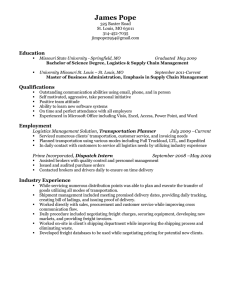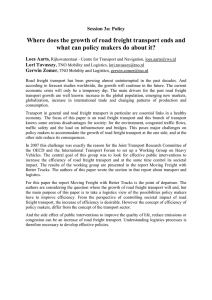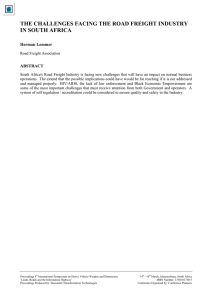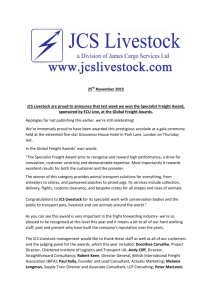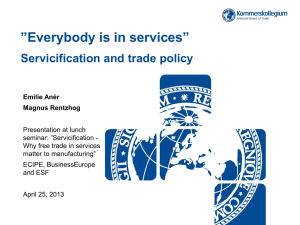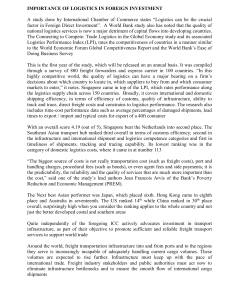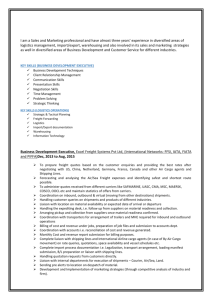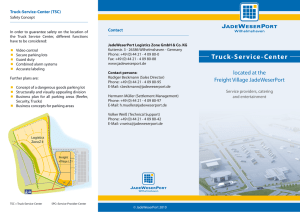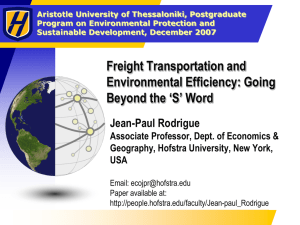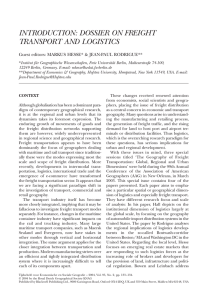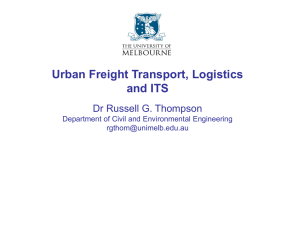Gerwin Zomer (TNO) Loes Aarts (RWS) WHERE DOES THE GROWTH OF ROAD
advertisement
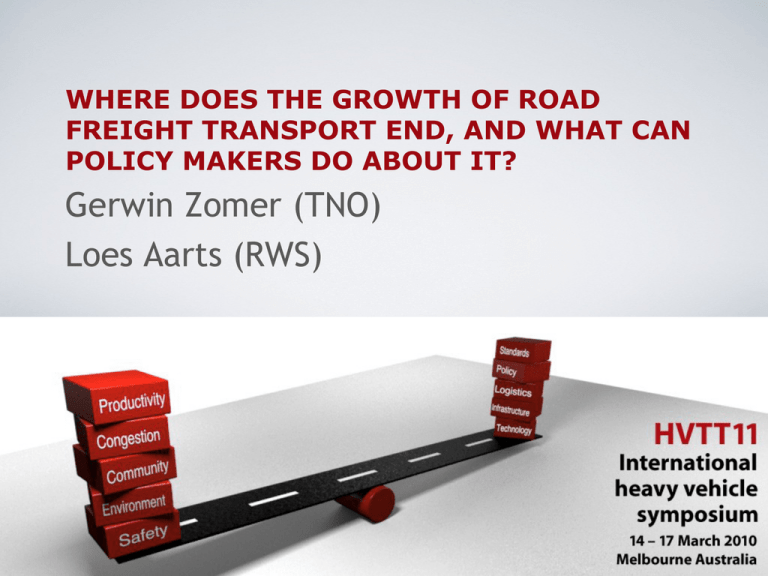
WHERE DOES THE GROWTH OF ROAD FREIGHT TRANSPORT END, AND WHAT CAN POLICY MAKERS DO ABOUT IT? Gerwin Zomer (TNO) Loes Aarts (RWS) Introduction Motivation: OECD study Moving Freight with Better Trucks Two questions to be answered • • Where does the growth of road freight transport end? (Gerwin Zomer) And what can policy makers do about it? (Loes Aarts) Conclusions History • Strong growth European road freight ­ ­ Average + 3.2% per year In US + 1.9% per year • Rail and IWT stable • Increased share of road ­ ­ 73% in continental transport 46% of all modes Forecast Recent forecast studies ­ ­ Fo r e c a s t EU r o a d fr e ig h t tr a n s p o r t Transvisions Freightvision 3000 2500 Based on TRANS-TOOLS (2030) and foresight methods billion TKM 2000 1500 1000 500 0 2005 2010 2015 2020 2025 2030 2035 2050 Results: ­ ­ 2005 – 2020: 1.6% per year 2005 – 2030: 1.0% per year IN T R A E UIm p o r t/e xp o r t o u ts i d e E U Main drivers of growth • Economic growth and growth of prosperity • Changing patterns of production and consumption • Evolution of transport costs Evolution in road freight transport efficiency • Transport efficiency = productivity vs costs • Productivity increased: average payload, empty runnings, fleet utilization Average loading of all laden heavy vehicles 20 • Cost reduction under pressure by wages and fuel costs in tonnes 18 16 United Kingdom 14 Netherlands 12 Sweden 10 France 8 6 1980 1985 1990 1995 2000 2005 Reflection on growth I • Decoupling GDP/ transport elasticity down • Production/consumption local to local; Eastern Europe and North Africa • Transport costs/efficiency transport costs factors all rise; rise of logistics costs as % of GDP; potential in cutting empty runnings is modest Reflection on growth II • From demand driven scenarios to including supply related constraints • Facilitating growth no longer self-evident • Recent ‘2050’ scenarios take into account constrained and reduced mobility • Nevertheless, improving efficiency seems to be the answer to balance policy needs And what can policy makers do about it? Efficiency In everyone’s interest? Efficiency means less Not impeded by any knowledge on logistics … Different perspectives, risk for ineffective measures • Public interest can be against the interest of individual companies • Regardless of the different interests within the supply chain • Possible conflicting public needs Logistic efficiency ≠ transport efficiency • Service level requirements – Rush orders • Minimise total logistic costs (not only transport) – EDC: Extra handling, more transport – Order quantity/order frequency (small replenishment orders) OECD-report: Moving freight with better trucks OECD working group on Heavy Vehicles: 2007 - 2009 Purpose: identify potential opportunities for greater efficiency and higher productivity and at the same time reduce negative impact of road freight transport Selected measures: ­ ­ ­ ­ Reduction of fuel consumption Improve productivity Enlarge capacity Improve the use of the infrastructure network Reduction of fuel use Improved engines, optimized aerodynamics, reduced rolling resistance tires, optimized driveline, reduce energy needed for auxiliaries and eco-driving. In everyone’s interest, if investments will pay back Improve productivity Collaboration within the supply chain, further implementation of ICT, reconsidering Just-in-Time and planning outside rush hours. In everyone’s interest, if on a voluntary basis and tailormade solutions Enlarge capacity 1. Increasing the maximum weight and dimensions of heavy vehicles In everyone’s interest, if under the right conditions 2. Require a minimum payload Not in everyone’s interest! Improve the use of infrastructure Remove impeding rules, increase use of smart traffic management, dedicated lanes, upgrading heavy truck traffic routes, create logistics parks near cities and introduce PBS In everyone’s interest, if access is not limited Conclusions Where does the growth of road freight transport end? • • • Flattening growth rates in developed countries expected Scenarios to cope with uncertainty Striving for efficiency is in all cases a good transport policy target And what can policy makers do about it? • • • Transport efficiency and logistics efficiency often goes hand in hand, not always Understanding logistics essential for effective transport policy Taken transport efficiency measures that will lead to logistics inefficiency are up to politicians (as is the other way around)
